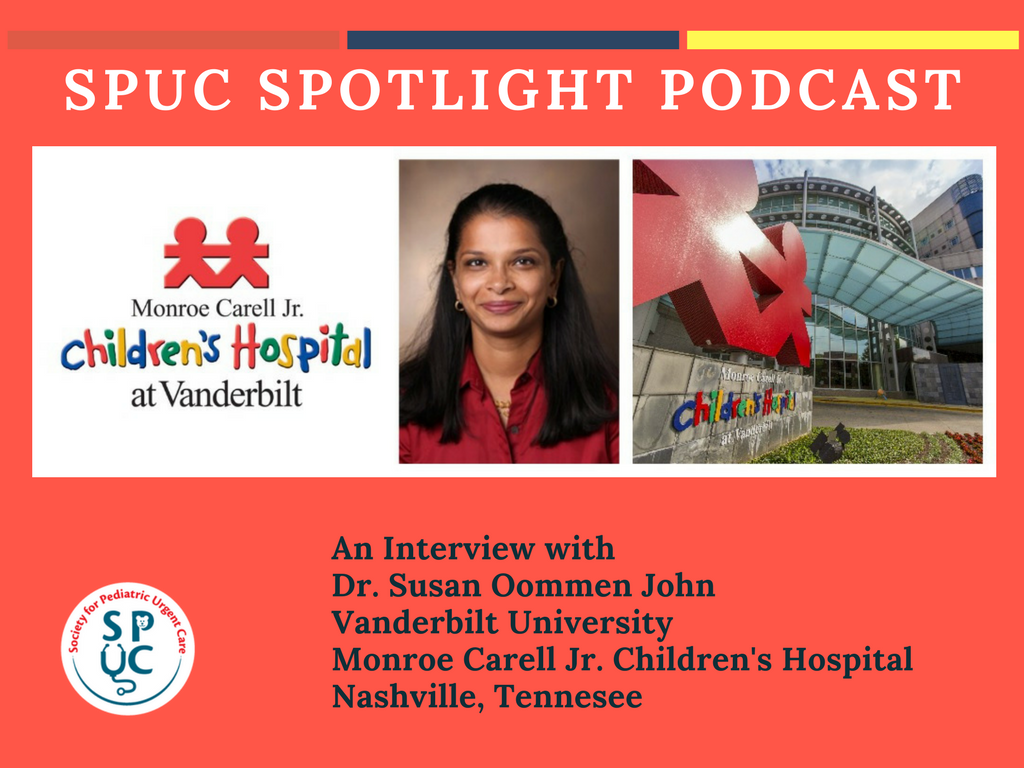February, 2018
SPUC Spotlight Podcast: Dr Susan Oommen Johns
Vanderbilt University
Monroe Carell Jr. Children’s Hospital
Nashville, Tennessee

Today’s guest for the Society for Pediatric Urgent care is Dr. Susan John. And you are at Vanderbilt University Medical Center. Tell me a little bit about how you came to pediatric urgent care — how you came to pediatrics and how you came to urgent care.
Dr. Susan John: Thank you. I came to pediatrics, in med school, as I did my rotations and wasn’t quite sure what I wanted to do and when I did my peds rotation, I kind of fell in love with that patient population and just really enjoyed it. One of the things I really enjoy about pediatrics is that, I think, as soon as kids start feeling better, they immediately start showing signs that they are feeling better and they want to feel better, and happy and laughing and smiling and it’s always gratifying to see that so quickly in pediatric patients.
What are the specific challenges you find in pediatric patients?
Dr. Susan John: Obviously, they don’t understand exactly what is going on, in the younger child. And there’s the element of fear, and parents are anxious, and children can play off of that. So it’s just trying to put them at ease, trying to put families at ease. But, once you’re able to establish that, I feel like the patients respond quickly to you.
Have you come up with any special techniques for getting over the verbal hurdle with very young children?
Dr. Susan John: I guess just trying to get at their level; don’t talk to them, kind of play with them and engage with them is usually what I do to kind of establish that. In the urgent care setting, it’s a little different, in that it’s not like going to your primary care, where they are familiar with that environment and have seen the physician before. We have a much shorter amount of time to kind of establish that relationship with them. So, just kind of being playful with themm, I think would be the biggest thing.
I mentioned that you’re at Vanderbilt University Medical Center. Is your practice all practice? Do you do academics as well? How does your day — how does your week shake out?
Dr. Susan John: We have five clinics that are located, satellite locations away from our main campus in Nashville itself. They’re all probably about thirty minutes from our main Children’s campus . We do have some student learners that are in our practice as well, that come out to do rotations with us. So we do have that aspect of academics. And then we come to the main campus for the meetings and other didatics that are available to us through the main campus.
Are you mostly at the main campus? Or are you at one of the satellites?
Dr. Susan John: I rotate between all of our satellites. We actually don’t have a location at the main campus itself. All of our locations are satellite locations.
Do you find different kinds of problems present themselves at different locations?
Dr. Susan John: I’d say it’s probably fairly even between the clinics. I don’t find that one location tends to only get a certain problem, per se. It seems like it’s a fairly even distribution.
Now Nashville’s something of a tourist city. Do you wind up with people who aren’t local. And then do you make any special effort to deal with their home pediatricians once they leave you?
Dr. Susan John: Like I said, most of our clinics are about thirty minutes from downtown. We don’t see as many out-of-town visitors as I would say in our downtown location, in the ER downtown. This is more people who are in those communities, who live in, this is their community, and this is who we see typically in our clinics, typically, just because it’s kind of embedded into the community, as opposed to in areas where tourists would be visiting.
Tell me about the typical staffing level at any of the satellite clinics.
Dr. Susan John: for the most part we have a PSR front desk person that’s with us. We have an MA who helps with triaging and then we have a nurse and we have one physician. We have a couple of clinics, their volume warrants that they have two providers and so we usually have an additional MA or nurse to help when we have an additional provider.
You mention volume. What is a typical volume?
Dr. Susan John: Our clinics on weekdays are open from 6 in the evening until 9:30 and then on the weekends from 12 to 8. In those weekday hours, I’d say we see, probably, average 15 to 20 or so patients. And they weekends, in the thirties.
Are you able to deal with virtually all of the patients on site? Do you need to send folks to the emergency room?
Dr. Susan John: We do, on occasion, have to send patients to the emergency room, once we have kind of exhausted our resources or if they seem like they’re going to need to be admitted to the hospital, then yes, we do end up transferring patients over to the emergency room at Children’s.
You’ve been with the Society for Pediatric Urgent Care since just about the beginning. What prompted that and what is your special interest with the group?
Dr. Susan John: This group is very unique in that this is definitely a need. There have been pediatric urgent cares in different parts of the country for quite a few years now but have not really had a chance to communicate with each other. And this group that kind of brought this Society together really worked hard to collaborate together and saw that there was a need for this. And I really feel like it’s been a wonderful resource. It’s so nice to be able to meet with a small group that is now continuing to grow, to hear their experiences and to also kind of validate that some of the problems that we’re dealing with, other places are dealing with, trying to hear their solutions. And it has really just been a great support and a great resource to have. And I think pediatric urgent care is definitely a quickly growing field and to have this group has been extremely helpful.
Can you share anything that you’ve been able to share with the other providers — or that you’ve learned from them through SPUC?
Dr. Susan John: Hearing that things we thought are maybe particular problems to us that other places have dealt with, especially with programs that have been in place. We didn’t start urgent care here until 2013, and so it’s definitely a new and quickly growing program for us. And to hear how things have grown in other places and how they’ve overcome that and seeing where they are moving to, helps to kind of guide us and see how we can work through those challenges that we meet at times.
Were you one of the people, five years ago — you say “we started,” did you actually help start it?
Dr. Susan John: We had a medical director who started it. I was working in the Fast-Track of our ED when the first clinic was opened, and was working in the Fast-Track, and occasionally in the after-hours clinics as well, and then in 2015 moved over completely to just after-hours.
As you talk to people around the country, do they see different — do they see the same kind of problems that you do? Do they see different problems?
Dr. Susan John: At the meeting recently, someone said, “If you’ve seen one urgent care, you’ve seen one urgent care.” Meaning that every urgent care is set up slightly different and I think everybody faces a unique set of problems, just because no two are alike. What each urgent care offers is different, and then the problems to go along with that then tend to be different. So you kind of hear what you’re doing, you hear what other people are doing and it helps you kind of see, “Oh, well, this works, actually is working well, we thought, we didn’t realize how well this was working for us. Or, maybe this is a way we can improve, ” listening to the thoughts of others, and I think, a lot of times , even their experience, just having gone through it. For example, we recently transitioned to EPIC as our EMR, and prior to, as we were in the building phase of that, I reached out to other institutions that were also on EPIC, to ask them, “What are things that work well in EPIC for you? What are things that you would recommend that we do? How can we kind of tailor this to be most efficient and effective for us?” And I was able to get some feedback from other institutions. It was through SPUC that I was able to have that resource to do that.
In the five years that they’ve been operating from Vanderbilt University Medical Center, how have parents and patient responded and any interest grown in the urgent care?
Dr. Susan John: That’s the one thing that I always notice, irrespective of location, is how grateful families and parents are to have this resource in their community. Like I said, these are all in, I guess you would say, suburbs of Nashville, communities that are used to getting everything that they need, right there in their community. They don’t typically need to go to Nashville to get other things, and so they are used to getting their services right there n the community. So they are very thankful and grateful to have pediatric urgent care right there at home and not have to go anywhere else. ‘Cause they wouldn’t necessarily travel to the emergency room — a lot of times it’s not problems that would necessarily warrant an emergency room visit, but they would definitely like to have their child seen and taken care of and feeling better and they’ve very appreciative and often are expressing how thankful they are to have us right there in their community.
I asked how the parents have reacted. How have the local providers responded to you?
Dr. Susan John: I think they’ve been, you know it was new in Nashville at that time. There weren’t really many urgent cares and so there was obviously some hesitation. But now they are very, I think they understand that urgent care is a part of medicine and since that is now a very booming part of medicine they would rather a pediatrician see their child, and they are thankful to have us. And we have pediatricians who call and say, “I’m sending a patient over,” and are just as well, are happy to have us in their community.
What do you see as the future of pediatric urgent care?
Dr. Susan John: I think it’s something that patients and families have now grown to use; they utilize it as another form of care. They still understand that their primary care has an important role in their child’s health care but there are just those instances where their primary care office can’t stay open all the time, but when your child is crying in pain with an earache, you as a parent want to do something to be able to fix that. And so, if that means being able to utilize a pediatric urgent care, I think every parent is extremely appreciative to have that option.

